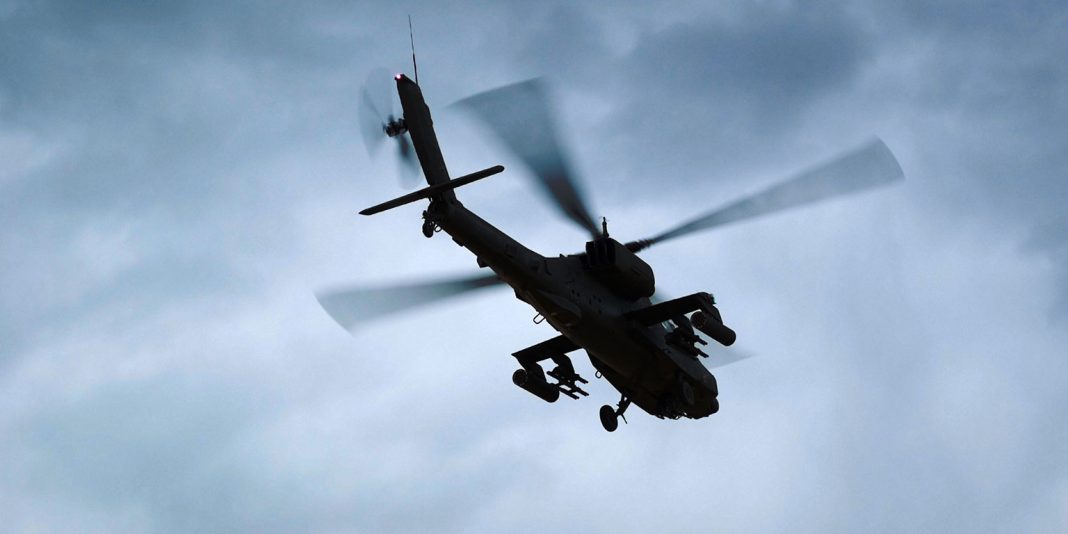Not many nurses have wielded an assault rifle to defend their patient in the Somalian desert. The Bay of Plenty Times profiles retired army nurse Judith Telford.
Judith Telford cocked her Steyr semi-automatic assault rifle.
It was the summer of 1994 and there was no time to think about who might fire first. Her Saint Christopher pendant clung to perspiring skin. She lifted her firing arm higher, the red cross emblem on her upper limb clearly visible.
This wasn’t how she’d imagined nursing: stuck in this God-forsaken place in the Somali desert, risking her life for another.
She and her flight nurse colleague stood on each side of their Bell212 Canadian helicopter. Inside an injured Somali wriggled. “You’ve got our brutha,” the approaching group of Somalis spat.
Alone in the desert, Telford’s military team had lost their number one engine on takeoff. They returned to this spot, an airstrip popular for drug runs. Alone with no radio, while the pilots and doctor returned to their compound to request a replacement chopper, the two women clung to their weapons.
“You’ve got our brutha,” the ascending group repeated. “Back off,” Telford said, cocking her rifle. And they did.
Measuring a mere 1.549 metres, Telford is one tough cookie.

The 57-year-old Papamoa woman disagrees her career is anything extraordinary, but her war stories tell you otherwise.
She was “married” to the military for 28 years and posted 15 times with the Royal New Zealand Nursing Corp and Air Force, with three major deployments to Somalia, Afghanistan and East Timor.
Most memorable was the ’94 Somalia trip. The Kiwi contingent arrived in the Horn of Africa not long after two American Black Hawk helicopters were shot down. She was the only medic in the 65-plus contingent, and for seven months found herself challenged, stressed and frightened like she’d never been before. “It was the pits, really.”
The military had their own compound that Somalis would work in during the day. At around 2pm, the Somalis would knock off and chew the drug khat, a flowering plant.
“The next thing, you’d have scuds (missiles) coming over you. They’d be having warlord fights. When you went out of the compound, you were always in a convoy, always armed. Weapons out the window … Because it was so unpredictable.” Even children couldn’t be trusted.
Carrying a semi-automatic weapon was standard kit for Telford, who was right-sighted but left-handed. Normally officers carry pistols but the military didn’t have enough to go around.
She recalls landing in a grid reference and she and her team had no idea how they were going to be received. “A couple of times we were literally running out of the village with a casualty. We would check our aircraft every day we landed and see how many holes had gone through.”
To add to this insanity, Somali women in burkas, some pregnant, were placed in front of armed men as shields. “Women and children were worthless to the Somalis. Camels were far more important.”
The experience changed her outlook on life, and she grew up quickly.
Stuck in the Kiwi contingent compound, Taniwha Hill, missiles would fly overhead and bullets whizzed through their tent line.
Injury-wise, she treated everything from gunshot wounds to malaria, dengue fever, Aids and shark bites. There were maimed children, and children who had been burnt by their parents to rid them of “the evil spirit”.
A women’s clinic was set up to provide contraceptives, but it was a fruitless exercise.
“You couldn’t give them a packet of pills because they would sell that. So, they would come in each day for their tablet, and come back pregnant.”
The women would hide the pill in a hole in their teeth and gave it to the chickens because the hormones made chickens fat. “It’s a backwards country but very innovative, you know?”
Sharing these stories, there’s nothing visible to indicate Telford was once a woman dressed for conflict.
Today, she has a rainbow-coloured crystal stud in each ear, shaped like a tiny dress. Her lips are painted coral, the same colour as her shirt.
On retirement from the military, she had to hand her uniforms back, but still has her heavy black boots and green flight suit.
She has a room in her house adorned with photos, certificates, badges, berets and her lemon squeezer. As a side note, she got the lemon squeezer stuck in a rolled up tent line when meeting patron for the Royal New Zealand Nursing Corp, Princess Anne.
Pride of place in her lounge is a skinny panoramic photograph of Somalia. She’s seen more gore and heartache than most hardened medical professionals in New Zealand.

Telford began her career at Waiouru Military Camp in 1985 and rose through the ranks from lieutenant to squadron leader.
She’s worked in neurosurgery, as a trauma nurse, Defence Health Services school instructor and a flight nurse bringing sick and injured Kiwis back home from as far away as New York.
“Nursing in an aircraft, it’s my passion.”
She was initially scared about hanging up her military uniform.
“You live in this big family for 28 years and it’s kind of like there’s civvy street, and us. Going back out, I just didn’t know how well I would cope.
“People say to me: ‘Did you get married? And I say: I married the military. Like, I have had a number of boyfriends, but it was all about my career.”
And of children: “I guess you just get to the age where you go, ‘I would be really selfish if I had a child now.’ … It had to be the right circumstances, and that didn’t happen. I enjoy my nieces and nephews.”
The youngest of three children and the only girl, she’s at a point in her life where she can afford to be open.
“Knowing that I don’t have to deploy again, I can be a lot more honest. Sometimes the worst thing you’re seeing isn’t the gore and the detail. It’s the total destruction … Why are we here? Why are we doing this?”
In 2002 she helped in the transportation of patients from the Bali bombings, travelling in a Hercules with an air force sergeant and three civilians.
“We were meant to bring back three people … Two never made it, they died on route, and the third person, Darcia, was burnt from head to foot.
Did she ever get used to seeing tragedy? She says “yes”.
“There’s something about putting on a uniform. It kind of protects you. You just get in there and do your job. And then afterwards, you think about it.”
She has countless photos from her deployments. One shows her resuscitating a baby in the troops’ deployable hospital in East Timor in 2000. The baby, a twin, had been brought in by helicopter from a remote area.
“You know, you have to say to yourself, if they can’t breathe on their own, what are we doing? Because you can’t incubate them. There is no paediatric intensive care in East Timor.”
She tells another story of a 16-year-old girl suffering a pulmonary embolism and dying in a medical tent of respiratory distress. Medics transported her body back to her remote village.
“The whole village came out and [we] just got swamped. We got quite a bad name. ‘Don’t go to the white man’s hospital because you come out dead,’ and that wasn’t untrue because we would see the worst cases. They’d already been to their medicine man, and came to us as their last ditch.”
Staff were required to go through a post deployment brief on the way home. Humour got them through a lot, she says.
She was with the NZ Nursing Corps tri-service corps for 20 years, before going full-time with the Air Force in 2005 when she took on the task of setting up a new state-of-the-art “aero-medical capability” (aka a flying hospital) in a Boeing 757.
She resigned when the project stagnated. “I completed as much as I could do and we were waiting for certification which is an extremely long, drawn-out process. Military was going down a different line; it had a new generation shaping it [and it] was time to move on.”
Her exit included one last mission to the US. Telford joined the team who flew on a Boeing to Washington DC to bring injured soldiers who’d been fighting in Afghanistan home. It was a 2.5 day journey.
“I couldn’t have been prouder … It makes me feel emotional just thinking about it. It was such a perfect way to end my military career to see this capability finally used.
“[Working at altitude] is not like an ED department. You can’t go ‘crash team’: there is no crash team, you’re it. Once you’re in the air, you’re in the air. It’s a challenging, challenging environment.”
Following her retirement from the Defence Force at the end of 2013, she worked in aged care in Hamilton and Cambridge. A move to Papamoa with Burmese cats Louie and Lacey and Cairn Terrier Chardonnay, beckoned last year. After a stint as hospital coordinator at Cedar Manor, she secured her “dream job” as a community advisor at the Stroke Foundation.
These days she lives a much quieter life of cross-stitch, cooking and gardening. Few, if any, of her clients know of her background. Some don’t even know she’s a nurse. She speaks at women’s clubs but doesn’t see herself as “anyone special”.
“There will always be wars,” she muses. “The war today is just unpredictable, happens anytime, anyplace. You just see it every night on the news, don’t you? Another suicide bomber. How do you fight against that? People don’t do a 20-year [military] career any more. It’s five years … Young people get it there, grow up, get challenged, might do a tour, come back, get out.”
The other day, a Hercules roared over Tauranga. As Telford searched the sky, a kaleidoscope of memories hit her.
One day she’ll write a book. The only problem: “Where do you start? Where do you finish?”





















